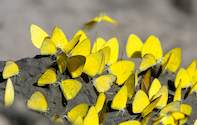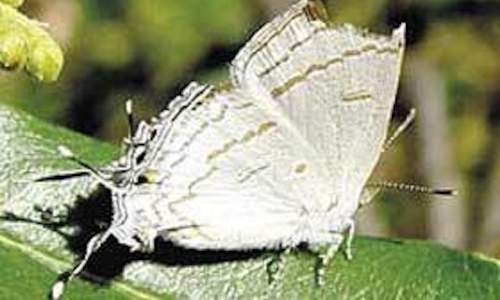

Butterflies in winter? It may seem absurd, but there are several butterflies that are on the wing the whole year round.
There are several butterflies that occur throughout the Kruger National Park and also many that occur throughout the year. Granted, these butterflies are usually of the more common variety, yet they stay beautiful and continue to invigorate our lives and warm our hearts.
Orange And Lemon (Eronia Leda)
This bright butterfly with its warm colours can be seen all year round. Perhaps it was named after the children’s song and game – “Oranges and lemons, the bells of Saint Clemens…” It is not hard to see where it got its name from, with its sulphur yellow and vivid orange tips.The female has a row of browner apical dots on the forewing and less orange. The underside resembles a yellowed autumn leaf with cryptic markings in brown to enhance this leaf-like look. Orange and lemon on a winter’s backdrop of abscised foliage. Skukuza Research Village.
African Migrant (Catopsilia Florella)
This butterfly gets its name from the fact that it too moves at quite a pace. It seems it is a rule in Africa – eat or be eaten. Hence they have adapted to turning the after-burners on. These butterflies are a common sight throughout the KNP and also all year round.The male has a greenish sheen to the white wings and the scientific name even alludes to a mirror because of it. The female form florella (meaning little flower) is vivid yellow when freshly emerged.
Scarlet Tip (Colotis Danae Annae)

The scarlet tip occurs throughout the Kruger National Park and also throughout the year, but it does so in two forms – the winter form and the summer form. The summer form has more black markings and a grey colouring in the mid-section of the wings, which is much paler in the male during winter.
The female displays a wide variation in her colouring as specimens from the Skukuza area exhibit. They may even have a yellow hue to the whitish parts of the wings. A haggard scarlet tip male being devoured by a mantid, and doing its part to ensure the continuation of the circle of life.
Striped Policeman (Coeliades Forestan)
Some butterflies do not even look like the generally accepted description of what a butterfly should look like – pretty and colourful. The striped policeman is one of the jets of the butterfly world. When it flies in a cloud-darkened or forested area it can only be noticed by the white flash on the underside of the hindwing.
It is fast! Fortunately, like most butterflies, they are attracted to flowers where they can be approached cautiously to be photographed. The males and females look alike and it is found everywhere in the Kruger Park.
Common Blue (Leptotes Pirithous Pirithous)
Some butterflies also do not fall into the generally accepted area of being medium-sized. The common blue has a wingspan of about 30mm, from wingtip to wingtip when the wings are spread. The scientific name Leptotes also means slender. The upperside of the male has a lilac-blue hue, hence the name.
The underside is a delicate cryptic design of intricate patterns in shades of brown on an off-white background. They feed on plumbago and may thus even be attracted to your garden. This butterfly occurs throughout the year, throughout the Kruger Park and indeed throughout South Africa.
Citrus Swallowtail (Papilio Demodocus Demodocus)
This large, handsome butterfly occurs throughout the year and everywhere in the Kruger National Park. It is also named the orange dog or the Christmas swallowtail because of its abundance during that time of the year. It is named the citrus swallowtail for it is a headache for citrus farmers all over, because it uses citrus as one of its more than 10 larval foodplants.
It is common because it has adapted to, and adopted, so many larval foodplants on which the eggs are laid. This butterfly occurs throughout Africa, Madagascar and in the Arabian peninsula. It has a very a similar cousin in Asia and Australia.
Banded Gold Tip (Colotis Eris Eris)
This butterfly is found at huge speed when flying about in its native savanna. It can often be slowed down to a standstill by the temptation of fresh nectar, as only nature can make it. The male has a broader black band about the bottom of the forewing, while the female also has less of a gold tinge to her wingtips.By Herbert Otto

 By the time a butterfly has reached maturity in the shape of a stately butterfly, it has survived 80 – 90 percent of its life's onslaughts...
By the time a butterfly has reached maturity in the shape of a stately butterfly, it has survived 80 – 90 percent of its life's onslaughts...